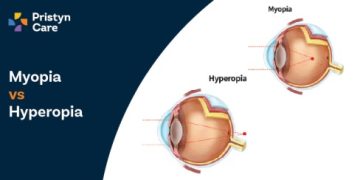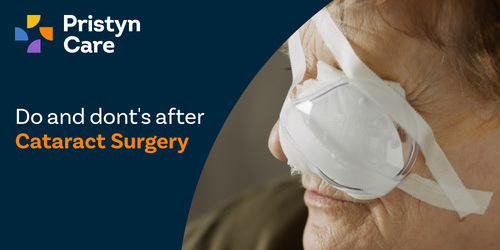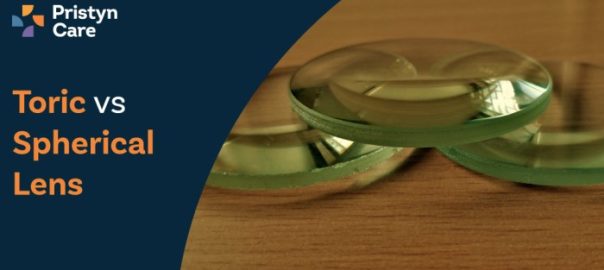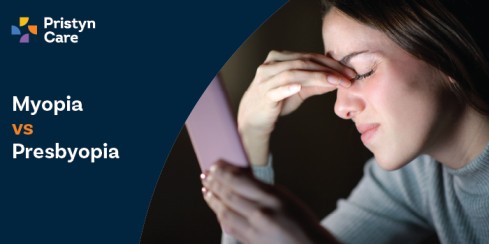![]() Views: 37
Views: 37
Myopia Vs Hyperopia
Do you find it difficult to read the text on your phone or see distant road signs clearly? You might be wondering whether you have myopia (nearsightedness) or hyperopia (farsightedness).
Dedicated Support at Every Step!
Our Doctors are available 24 hours a day, 7 days a week to help you!
These common vision conditions affect millions, impacting how well you see near and far objects. Myopia lets you see objects close up clearly but blurs those further away. In contrast, hyperopia makes it hard to focus on close objects while distant ones remain sharp.
In this blog, we will break down the differences between these two conditions, discuss their symptoms, causes, and explore effective treatment options. Ready to clear up the confusion about your vision? Let’s dive in and bring everything into focus.
Table of Contents
What is Myopia (Nearsightedness)?
Myopia, commonly known as nearsightedness, is a widespread vision condition affecting your ability to see distant objects clearly.
Myopia occurs when the shape of your eye causes light rays to bend (refract) incorrectly, focusing images in front of your retina instead of on it. This misalignment can result from a longer-than-normal eyeball or a cornea that is too curved for the length of the eyeball.
These structural anomalies can be influenced by genetics, meaning myopia can often run in families. Environmental factors, such as spending extensive time doing close visual work like reading or using computers, may also play a role in its development.
How the Eye Processes Images in Myopia?
In myopia, the eye's elongated shape or excessively curved cornea leads to a focus error. Here’s how this typically works:
- Light Focus: Instead of focusing directly on the retina, light focuses just in front of it.
- Resulting Image: This causes distant objects to appear blurry while close objects look clear.
- Corneal Curve: The cornea's steep curve means that the light bends too much before reaching the retina.
- Eyeball Length: An elongated eyeball stretches the distance between the lens and the retina, causing further focus disruption.
- Light Adjustment: The eye might attempt to adjust by squinting, which temporarily narrows the field of vision and increases the focus.
Common Symptoms and Signs
Myopia often develops during childhood and can progress gradually or rapidly. Early recognition of its signs is key to managing its effects effectively.
- Blurred Distance Vision: Difficulty seeing objects at a distance clearly, such as watching television or seeing the chalkboard in school.
- Squinting: Needing to squint to see more clearly.
- Headaches: Caused by eyestrain from the effort to focus on distant objects.
- Eye Fatigue: Feeling tired eyes, especially after prolonged periods of work that require focusing on distant objects.
- Night Vision Issues: Increased challenges in seeing in low light conditions.
No Cost EMI, Hassle-free Insurance Approval
What is Hyperopia (Farsightedness)?
Hyperopia, or farsightedness, is a common vision condition that affects your ability to see nearby objects clearly.
Hyperopia results from a shorter-than-normal eyeball or a cornea that is too flat, causing light entering the eye to focus behind, rather than on, the retina. This focus discrepancy makes nearby objects appear blurry.
Genetic factors often influence hyperopia; it tends to be hereditary, passing from parents to children. Additionally, age-related changes in the eye's lens can exacerbate or lead to hyperopia, particularly in adults over 40 years of age.
How the Eye Processes Images in Hyperopia?
In hyperopia, the eye does not refract light adequately, leading to a focus point behind the retina. Here’s a closer look at this process:
- Light Focus: Light rays converge behind the retina instead of on its surface.
- Resulting Image: This improper focus makes near objects look blurry, though distance vision remains relatively unaffected.
- Corneal Flatness: A flatter cornea does not bend light sufficiently, misdirecting it towards the back of the eye.
- Eyeball Length: A shorter eyeball shortens the path light travels before reaching the retina, causing focus issues.
- Adjustment Efforts: The eye might strain to bring near objects into clearer view, often unsuccessfully.
Common Symptoms and Signs
Recognising the signs of hyperopia can help manage its impact on vision and daily activities effectively.
- Near Vision Strain: Difficulty focusing on close tasks like reading or sewing.
- Averting Near Tasks: A tendency to avoid activities that require close focus.
- Eye Strain: Experiencing aching or burning eyes, particularly during close work.
- Headaches: Frequent headaches from prolonged near-vision tasks can indicate uncorrected hyperopia.
- Blurry Vision: This may improve when looking at distance objects but worsens with closer ones.
Comparative Analysis
Here, we get into the distinctive characteristics and effects of myopia and hyperopia, two prevalent vision impairments.
Differences in Visual Impairments: Myopia vs. Hyperopia
Myopia (nearsightedness) and hyperopia (farsightedness) primarily differ in how they affect the clarity of vision at various distances. Myopia results in blurred distant vision, whereas hyperopia leads to difficulties in seeing close objects clearly.
- Focus Point: In myopia, the eye focuses images in front of the retina, making distant objects appear blurry. In hyperopia, images are focused behind the retina, blurring nearby objects.
- Causes: Myopia often develops due to a longer eyeball or overly curved cornea. Hyperopia can result from a shorter eyeball or a flatter cornea.
- Correction: Glasses or contact lenses correct myopia by diverging light rays, whereas they converge light rays to correct hyperopia.
Age of Onset and Progression
The age at which people develop these conditions and how they progress over time can vary significantly between myopia and hyperopia.
- Myopia: Often begins in childhood or adolescence. It can progress rapidly during school years but typically stabilises in early adulthood.
- Hyperopia: Many children are born with hyperopia, which may lessen as the eyeball lengthens with growth. However, age-related hyperopia can develop or worsen in adults over 40 due to lens thickening.
Impact on Daily Activities
Both myopia and hyperopia can significantly affect daily activities, but in different ways depending on the nature of the visual impairment.
- Myopia: Individuals may struggle with activities that require sharp distance vision, such as driving, sports, or recognising faces from afar. This can lead to squinting and eye strain in an attempt to see clearer.
- Hyperopia: Affects tasks that require close vision, such as reading, sewing, or using a smartphone. This often results in eye strain, headaches, and avoiding detailed close-up work.
Diagnosis and Detection
Accurately diagnosing vision conditions like myopia and hyperopia is crucial for effective treatment and management.
Techniques Used in Diagnosing Refractive Errors
The diagnosis of refractive errors involves several key techniques. These methods assess how well your eyes focus light, which is essential to determining the presence of myopia or hyperopia.
- Visual Acuity Test: This involves reading letters from a chart positioned at a distance to measure how well you see at various lengths.
- Refraction Assessment: Using a device called a phoropter, an optometrist places different lenses in front of your eyes to determine the best combination that corrects your vision to normal.
- Retinoscopy: In some cases, especially for children, a light is shone into the eye, and a retinoscope is used to observe the reflection from the retina to approximate the correct lens power.
Role of Regular Eye Examinations
Regular eye exams are vital, not only for detecting refractive errors but also for monitoring the overall health of your eyes.
Importance of Regular Exams
- Early Detection: Regular exams help in the early detection of myopia and hyperopia, which can lead to timely corrective measures.
- Monitoring Progression: They are crucial for tracking the progression of these conditions, particularly important in children whose eyes change rapidly.
- Overall Eye Health: These examinations can also identify other eye conditions and general health issues, such as diabetes and high blood pressure, which can affect your vision.
Identifying Myopia and Hyperopia in Children and Adults
Detecting these conditions in both children and adults requires a keen understanding of the symptoms and the use of appropriate diagnostic tests.
Detection Strategies
- In Children: Children may not always express visual difficulties clearly. Clues like squinting, sitting too close to the television, or avoiding visual activities can prompt a vision test.
- In Adults: Adults might notice difficulty in performing tasks like reading or driving, which could indicate the need for an eye examination.
Treatment Options
Effective treatment for vision impairments like myopia and hyperopia can significantly enhance quality of life.
Corrective Lenses: Glasses and Contact Lenses
Corrective lenses are the most common and accessible treatment for correcting refractive errors.
- Glasses: The simplest form of correction, glasses adjust the focus of light entering the eyes, thereby compensating for the refractive error. They can be specifically tailored to individual vision needs, including bifocals for those needing different strengths for near and distance vision.
- Contact Lenses: Offering more natural vision by sitting directly on the eye, contact lenses can provide a wider field of view than glasses. They come in various types, such as soft, rigid gas-permeable, and special orthokeratology lenses that reshape the cornea overnight to temporarily correct myopia.
Surgical Treatments: LASIK, PRK, and Others
For those seeking a long-term solution to refractive errors, surgical options are available that reshape the cornea and permanently correct the vision.
- LASIK (Laser-Assisted In Situ Keratomileusis): This popular procedure involves creating a thin flap in the cornea, then using a laser to reshape the underlying corneal tissue. It offers a quick recovery and significant improvement in vision, often enabling patients to forgo glasses or contact lenses.
- PRK (Photorefractive Keratectomy): Similar to LASIK but without creating a corneal flap, PRK removes a small amount of the cornea's surface. It's particularly suited for patients with thin corneas who are not candidates for LASIK.
- Other Procedures: Advanced options like LASEK (a variant of PRK), implantable lenses, and corneal ring implants are also available for specific cases, offering alternatives for those not suitable for LASIK or PRK.
Prevention and Management
While refractive errors like myopia and hyperopia often involve genetic components, effective management can mitigate their impact on daily life.
Can Myopia and Hyperopia be Prevented?
Complete prevention of myopia and hyperopia is currently not possible due to their strong genetic links. However, there are strategies to manage their onset and progression.
- Regular Eye Check-ups: Early detection through regular eye exams can help manage these conditions before they worsen.
- Visual Hygiene: Encouraging breaks from close work and using adequate lighting can reduce eye strain.
- Protective Eyewear: Using sunglasses to protect eyes from UV rays can help maintain overall eye health, though it does not directly prevent myopia or hyperopia.
Strategies for Slowing Progression
Although outright prevention is not feasible, slowing the progression of myopia and hyperopia is achievable with proactive measures.
- Controlled Lighting: Ensuring sufficient lighting while reading or doing close work to minimise strain.
- Time Outdoors: Increasing time spent outdoors has been linked to a reduction in the progression of myopia in children.
- Appropriate Corrective Lenses: Using the correct prescription lenses can prevent the conditions from worsening.
Role of Genetics and Environment in Refractive Errors
Both genetic and environmental factors play significant roles in the development and progression of refractive errors.
- Genetics: If one or both parents have myopia or hyperopia, the chances increase significantly for their children. Genetic predisposition affects how the eye develops, particularly the shape of the eyeball and the cornea.
- Environment: Lifestyle factors such as prolonged close-up tasks like reading, computer use, and lack of outdoor activities contribute to the worsening of these conditions. Research suggests that balancing near tasks with outdoor activities can help manage the progression.
Vision Forward: A Clearer Perspective
As we got to the differences between myopia and hyperopia, it's evident that both conditions offer unique challenges but also manageable solutions. By taking charge of your eye health through informed choices and timely care, you can significantly improve how you experience the world. Opting for regular eye check-ups, embracing the right corrective lenses, or considering surgical options are all steps that lead to better visual clarity.
Actively managing your vision not only enhances your ability to engage with your surroundings but also enriches your quality of life. It’s about more than just correcting a blur; it’s about refining your view of the world and enjoying everything with crystal clear vision.
Step forward with confidence, knowing that a clearer path lies ahead.










